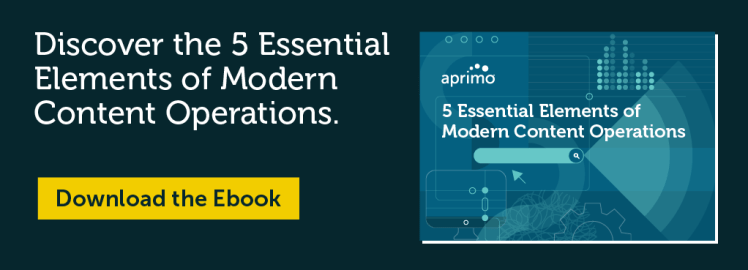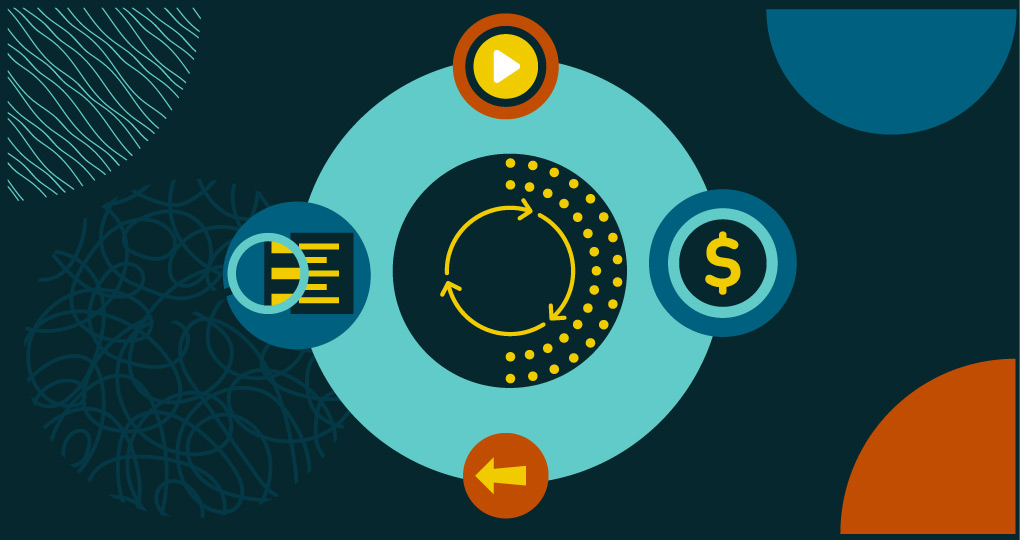Process and framework are the cornerstones of any operation, and content ops are no different. Without a structured and efficient asset library, companies struggle with siloed and decentralized files, tracking content changes, regulating access, and controlling the lifecycle. Where visibility fails, challenges follow.
A well-structured content lifecycle management practice alleviates these issues. It provides organizations with clear brand guidelines and policies regarding asset creation, ownership, hierarchy, tracking, and disposal. By understanding and following these practices, organizations can be sure they have a reliable digital asset management (DAM) system for managing their customer-facing content.
Today, we’ll discuss the details of building a strong CLM practice:
- What content lifecycle management is
- What benefits content lifecycle management offers
- The 6 phases of content lifecycle management
- The challenges in building strong content lifecycle management
- Features to look for in a content lifecycle management solution
What is Content Lifecycle Management?
Content lifecycle management (CLM) guides content throughout its lifespan, from development and publishing to archiving. It allows businesses to streamline their content production process, better manage resources and assets, and optimize content for reuse or repurposing.
CLM also helps organizations maintain brand consistency by setting clear governance rules and guidelines for creating, editing, approving, and publishing content. With CLM, businesses ensure that all content is accurate, compliant with industry regulations and standards, and aligned with business goals.
CLM enables businesses to deliver targeted and personalized customer experiences, save time, and optimize spend and return on effort (ROE). It helps them make the most of their existing digital content and makes finding, tracking, and managing their assets easier.

Benefits of Content Lifecycle Management Software
Proper content lifecycle management offers organizations a range of time-saving, cost-cutting, and asset-control benefits. CLM ensures your content stays compliant, connects with audiences, and performs appropriately. Companies reap these rewards while making the content process faster, easier, and more cost-effective.
Better content governance: CLM helps organizations create standards and processes to ensure that content is accurate, compliant with regulations, and meets brand objectives.
Improved customer experiences: Businesses can use CLM to deliver personalized and targeted customer experiences.
Streamlined content creation: CLM simplifies content creation by making it easier to find and access existing assets and manage multiple versions of content. A platform with dynamic, contextualized search means content creators find what they need quickly and repurpose it for multichannel use.
Automate the process: Using a platform with dynamic workflows helps automate your content from creation to publication. It allows multiple stakeholders to collaborate in real-time and keep track of content progress, then simplifies approvals by enabling approval routing and sign-off.
Centralize assets: Organizing your assets with a CLM platform is key to any successful content marketing strategy. When assets such as videos, images, and text are centralized, it becomes easier to find, access, reuse, and repurpose them. This organization boosts productivity and eliminates the time-consuming process of searching for scattered files across multiple platforms (like scrolling through email threads for versions).
Improves brand consistency: CLM platforms allow easy and consistent application of brand assets across all content. This consistency eliminates guesswork to create a more unified brand experience, ensuring consistency throughout all content. CLM also allows users to customize content while adhering to core branding guidelines. This adherence ensures message accuracy and enhances the effectiveness of content campaigns.
6 Stages of Content Lifecycle Management
CLM is a continuous process through which each asset or piece of content flows. Brand managers and content teams must facilitate this process for a growing content repository, ensuring every asset is compliant, on-brand, and used to its full potential. Each asset goes through the following six stages of the content lifecycle:
1. Plan your content
The first step to successful content lifecycle management is planning. This includes mapping out the goals of your content or campaign, determining key messages to communicate, and establishing an editorial calendar. Successful content operations ensure all stakeholders know their specific roles and responsibilities and the goal of the content. Over half (58%) of marketers cite communications as their biggest challenge in content management.
Content planning should also include a timeline for content creation, review, and approval, as well as distribution processes for each stage of the content lifecycle. By properly mapping out the goals of your content or campaign upfront, you can align all stakeholders from day one.
2. Create content
Once the plan is in place, it’s time to execute. The CLM process provides a systematic way to create, review, and approve content. Build a plan and a technical approach that allows collaboration between the marketing team and stakeholders from various departments within the organization. Once all stakeholders are satisfied with the content, a review and approval process ensures it meets all brand and campaign requirements before distribution. This process allows organizations to ensure their message was crafted properly and that all necessary feedback has been addressed on time.
3. Publish and syndicate
Once the content has been created and approved, organizations can leverage the CLM process to syndicate their message across multiple channels. This structured approach allows organizations to easily create and distribute content tailored to the target audience across various channels. This ensures customers have an optimal experience when interacting with the organization’s messaging across all channels.
4. Optimize and reuse
Optimizing and reusing content is essential to maximizing return on investment. By leveraging the CLM process, organizations tailor existing content to fit different channels or audiences. This allows organizations to save money by using the same content in multiple places. This messaging optimization increases customer engagement while driving higher conversions, lower bounce rate, and better return on ad spend (ROAS). In addition to providing a better customer experience, repurposing content also helps organizations reduce the time and resources needed to create new content from scratch, leading to further cost savings.
5. Monitor and measure
Measuring content performance and production metrics such as return on investment (ROI) and return on effort (ROE) is fundamental to successful content marketing. How important? Over 70% of top-performing marketers measure ROI as part of their content operations.
Through analytics and data-driven insights, organizations can identify what content resonates with customers, determine which type of content produces better results, and analyze the overall ROI of their content marketing strategy. By making informed decisions based on data-driven insights and utilizing tools such as A/B testing, organizations can maximize their efforts’leading to increased conversions, improved customer engagement, higher sales volume, better brand recognition, reduced costs, and ultimately an overall increase in revenue.
6. Archive and manage
It’s important to not only create great content but to manage it properly. Here’s what effective archiving and managing of content looks like:
- Embedding embargo dates into the content so that it doesn’t appear until a particular time
- Restricting content to specific regions based on legal or political motivation
- Using digital rights management (DRM) technology to reduce the risk of unauthorized access
- Utilizing content lifecycle management (CLM) tools to control who has permission to view or edit the content
Continuing to monitor and audit existing content ensures that organizations are creating content that meets the current company goals and that past initiatives remain up-to-date and relevant.
Challenges in Enterprise Content Lifecycle Management
With the ever-changing communications landscape, staying on top of enterprise content management is vital. However, some common challenges can make strong content governance and lifecycle management more difficult. For example, organizations don’t always have the resources to create and manage content quickly, making it harder to stay up with current trends and demands. Often, companies implementing better CLM practices encounter the following challenges:
- Identifying and documenting policy and best practices for archiving and retrieving older content
- Ensuring content is secure and accessible at all times
- Establishing a consistent workflow to manage and store the content
- Keeping the content compliant with changing regulations or standards
- Making sure all stakeholders know how to access, update, and use the content
- Determining what information should be archived and for how long
A Content Lifecycle Management (CLM) platform can help organizations overcome these challenges. It automates and streamlines the processes necessary for proper content management, maintains security and compliance with changing regulations, provides an easy-to-use and secure platform for storing and retrieving content, and more.
With a CLM platform, organizations can create automated workflows for managing the lifecycles of their content, ensuring that it is always updated and correctly archived. Centralized files within a CLM platform make it easier for stakeholders to access, update, and use the content they need while ensuring that data remains secure.
All these features help organizations save time, money, and resources while keeping their content in compliance with current standards.
What to Look For in a Content Lifecycle Management Solution
When researching a content lifecycle management (CLM) solution, it’s important to consider the features and benefits that will benefit your organization. A good content management system should provide features such as automated content lifecycle management, centralized file storage and retrieval, security and compliance with changing regulations, and an easy-to-use platform.
Organizations should look for these top five features when evaluating a CLM solution:
- Automated workflows for managing the lifecycle of each piece of content from creation to end-of-life
- Centralized file systems with contextualized search (using metadata and tagging) for easy access and updating
- Security and compliance features with permissions-based access and encryption to ensure safe access for even the most sensitive assets and data environments
- An easy-to-use, secure platform with features for the distribution of content internally and externally, making it easy for content strategists, agencies, and end-users to receive and use assets
- Communication, collaboration, and version controls that allow users to create new content together, discuss plans and projects, and access assets without creating redundancy
Build Your Content Lifecycle Management Program with Aprimo
Aprimo’s comprehensive platform is a strong choice for organizations looking to gain more control and ownership over their assets, while still enabling users to access the content they need. With Aprimo, organizations ensure their data is always secure while providing teams with the features they need to create, search, and manage their growing libraries. Here are just a few of Aprimo’s top features:
- AI-powered DAM platform with robust features and contextual search for easy access to every asset
- Collaboration tools that allow teams to create, approve, and track content development
- DRM and permission controls to ensure compliant, controlled access to every asset
Download our ebook, 5 Essential Elements of Modern Content Operations, to learn more about how you can unleash the power of your omnichannel content.



